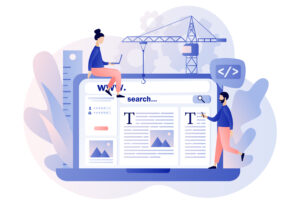The terms “web development” and “web design” are frequently used interchangeably in the dynamic realm of digital presence, causing confusion about their distinct roles. At first glance, it may appear to be mere semantics, but dig deeper and you’ll discover a world of differences that can have a significant impact on the success of your online ventures. Let’s dive deep into web development and design to better understand these two pillars of the digital landscape.
Table of Contents
Web Development: The Engine of the Digital Universe
Web development is the unseen engine that powers the websites you use every day. It’s like your car’s engine: necessary but often hidden from view. Web development is fundamentally concerned with the creation, maintenance, and optimization of websites and web applications. It is the intricate process of transforming static designs into dynamic, functional online experiences.
The Role of a Web Developer
Imagine you want to create an e-commerce website where users can browse, select products, and make purchases. The web developer steps in as the architect and builder of this virtual store. Here’s what they do:
- Coding: Web developers are proficient in various programming languages like HTML, CSS, JavaScript, Python, Ruby, and PHP. They use these languages to write the lines of code that make websites work.
- Back-End Development: This is where the magic happens behind the scenes. Web developers work on the server-side of websites, managing databases, ensuring security, and handling data processing. When you click “Add to Cart,” the web developer ensures your chosen item lands safely in your shopping cart.
- Front-End Development: The front-end is what you see and interact with on a website. Web developers ensure that the user interface is visually appealing, responsive, and easy to navigate. They use HTML, CSS, and JavaScript to create the layouts and interactive elements you love.
- Web Performance Optimization: Web developers are performance aficionados. They optimize website speed, ensuring that pages load quickly and efficiently. Slow-loading websites are a major turnoff for users, and developers work tirelessly to prevent this digital faux pas.
- Responsive Design: In today’s mobile-centric world, web designers ensure that websites look and function flawlessly on various devices, from desktops to smartphones and tablets.
Tools of the Trade
Web developers are armed with a formidable arsenal of tools and technologies. Some of the popular ones include:
- Text Editors: Tools like Visual Studio Code and Sublime Text are the trusted companions of web developers for writing clean, efficient code.
- Version Control Systems (VCS): Git and GitHub help developers collaborate on projects seamlessly and track changes.
- Front-End Frameworks: Angular, React, and Vue.js are go-to choices for building dynamic front-end interfaces.
- Back-End Frameworks: Flask, Django, and Express.js make back-end development a breeze.
Web Design: Where Art Meets Functionality
What is Web Design?
Web design is the creative soul of the digital world. It’s the artistic process of designing the visual elements and user interface of a website. Think of web designers as the architects and interior decorators of the online universe. They craft the look, feel, and user experience of a website.
The Role of a Web Designer
If web developers build the foundation of a house, web designers are the ones who turn it into a cozy, inviting home. Here’s what a web designer does:
- User Experience (UX) Design: Web designers focus on creating a seamless and enjoyable user experience. They plan how users will interact with the website, ensuring that it’s intuitive and user-friendly.
- User Interface (UI) Design: This is where the aesthetics come into play. Web designers choose colors, typography, images, and layouts to create visually appealing websites. They make sure that everything looks harmonious and aligns with the brand’s identity.
- Prototyping and Wireframing: Before diving into the actual design, web designers create prototypes and wireframes to visualize the website’s structure and layout. This serves as a blueprint for the development phase.
Tools of the Trade
Web designers wield an impressive array of tools to bring their creative visions to life. Here are some popular ones:
- Graphic Design Software: Adobe Creative Suite, including Photoshop, Illustrator, and XD, is a designer’s dream for creating stunning visuals.
- Prototyping Tools: Sketch and Figma allow designers to create interactive prototypes for user testing and client approval.
- Color Palette Generators: Tools like Coolors and Adobe Color Wheel help designers choose captivating color schemes.
- Typography Resources: Google Fonts and Typekit offer an extensive library of fonts to add that perfect touch to web designs.
The Differences Between Development and Design
It’s All About Purpose
Web Development: If you’re all about functionality, problem-solving, and making things work seamlessly, web development is your playground. Web developers focus on the nuts and bolts of a website, ensuring that it operates flawlessly and delivers a top-notch user experience.
Web Design: On the flip side, if your heart beats for aesthetics, creativity, and the visual appeal of a website, web design is your calling. Web designers are the artists who turn a blank canvas into a masterpiece, making sure every element aligns with the brand’s identity.
The Skill Sets
Web Development: To excel in web development, you need to be a coding ninja. Proficiency in programming languages like HTML, CSS, JavaScript, and back-end languages is crucial. Problem-solving skills, attention to detail, and the ability to work with databases are also essential.
Web Design: Web designers need an eye for design, a knack for creativity, and a deep understanding of user psychology. Skills in graphic design, prototyping, and knowledge of design software are indispensable. Plus, staying updated with design trends is a must.
Collaborative vs. Individual
Web Development: Web development is often a collaborative effort. Developers work closely with designers, project managers, and clients to bring a website to life. Communication and teamwork skills are vital.
Web Design: While collaboration is crucial during the initial planning stages, web designers often work individually when it comes to crafting the visual elements. However, feedback and iterations are common in the design process.
The Tools of Choice
Web Development: Developers rely on text editors, version control systems, and a wide range of programming frameworks and libraries. Their toolkit is geared towards writing, managing, and optimizing code.
Web Design: Web designers prefer graphic design software, prototyping tools, and resources for choosing colors and fonts. Their focus is on creating the visual elements and user interface.
The End Game
Web Development: Web developers create the functional core of a website or web application. Their ultimate goal is to ensure that everything works smoothly, from interactive buttons to complex data processing.
Web Design: Web designers strive to create visually stunning and user-friendly websites. Their end game is to elicit positive emotions, leaving users with a memorable and enjoyable experience.
Harmonizing Development and Design
In the grand symphony of digital creation, web development and design are not isolated entities but collaborative partners. Success lies in their seamless integration, where the brilliance of coding meets the allure of design. Here’s how this collaboration unfolds:
Fluid Communication
The bridge between development and design is effective communication. When developers and designers collaborate seamlessly, the result is a website that marries flawless functionality with eye-catching aesthetics. A visually striking website means little if it’s not backed by robust functionality.
Iterative Refinement
The digital landscape is not static, and neither should your website be. Continuous refinement is the heartbeat of digital success. Regular collaboration between developers and designers ensures that your online presence evolves in tandem with industry trends and user expectations.
User-Centric Innovation
The end goal is not just a website but an experience. When development and design align with user needs and expectations, innovation flourishes. It’s about predicting user behavior, understanding their journey, and crafting a digital space that seamlessly aligns with their expectations.
FAQs:
Q1. Can one person be both a web developer and designer?
Absolutely! In fact, many professionals in the tech industry embrace both roles. These individuals, often referred to as “full-stack developers,” possess skills in both web development and design. It’s like having a superhero who can build the entire digital fortress from the ground up!
Q2. Which is more important: web development or web design?
Both are equally important, and their significance depends on the project’s goals. A visually stunning website won’t succeed if it’s plagued with functionality issues, and a flawlessly functioning website might go unnoticed if it lacks visual appeal. It’s the harmonious collaboration of web development and web design that creates a truly exceptional online presence.
Q3. How do web developers and web designers communicate during a project?
Communication is key! Web developers and web designers collaborate through meetings, project management tools, and sometimes even specialized communication platforms. Clear communication ensures that the final product aligns with the client’s vision and meets both aesthetic and functional requirements.
The Strategic Synergy of Development and Design
As we conclude our journey through the realms of web development and web design, it becomes evident that these two disciplines are not adversaries but partners in the grand dance of digital creation. Web development and design, each with its unique set of skills and contributions, come together to shape the virtual landscapes we traverse daily.
So, the next time you visit a website and marvel at its seamless functionality and captivating design, remember the unsung heroes – the web developers and web designers – who work tirelessly behind the scenes. Whether you’re drawn to the artistry of web design or the intricacies of web development, one thing is certain: understanding the differences between these two realms enriches our appreciation for the dynamic and ever-evolving world of the World Wide Web!
Web Development and Design: Strategic Synergy for Digital Dominance – because in the vast expanse of the digital universe, knowing who builds the engine and who designs the cockpit makes the journey all the more exhilarating!




